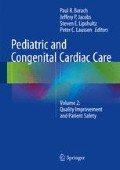Abstract
The measurement of safety in healthcare is challenging, yet the simple actions of identifying and measuring adverse events, accessible to all professionals, has the potential to be highly beneficial. The chapter provides an overall view of pragmatic concepts, methods and key points that may serve this objective.
Access this chapter
Tax calculation will be finalised at checkout
Purchases are for personal use only
References
Van der Shaaf T. Medical applications of Industrial Safety science. Qual Saf Health Care. 2002;11:205–6.
Brennan T, Leape L, Laird N, Localio A, Lawthers A, Newhouse J, et al. Incidence of adverse events and negligence in hospitalized patients: results of the Harvard medical practice survey study I. N Engl J Med. 1991;324:370–6.
Vincent C. Patient safety. 2nd ed. Chichester: Wiley; 2010. Institute of Medicine. To err is human: building a safer health system. National Academy of Sciences; 2000.
Reason J. Human error. Cambridge: Cambridge University Press; 1990.
Helmreich R. On error management: lessons from aviation. BMJ. 2000;320:721–85.
Amalberti R. The paradoxes of almost totally safe transportation systems. Safety Science. 2001;37:109–26.
Amalberti R, Hourlier S. Human error reduction strategies. In: Carayon P, editor. Handbook of human factors and ergonomics in healthcare and patient safety. 2nd edn. Hillsdale; 2011, chapter 24, 562-385-98, New Jersey: LEA; 2010.
Cullen D, Bates D, Small S, Cooper J, Nemeskal A, Leape L. The incident reporting system does not detect adverse drug events: a problem for quality improvement. Jt Comm J Qual Improv. 1995;21(10):541–8.
Aylin P, Tanna S, Bottle A, Jarman B. How often are adverse events reported in hospital statistics? BMJ. 2004;329:369–70.
Lawton R, Parker D. Barriers to incident reporting in a healthcare system. Qual Saf Health Care. 2002;11:15–8.
Resar R, Rozich J, Classen D. Methodology and rationale for the measurement of harm with trigger tools. Qual Safe Health Care. 2003;12:39–45.
Classen D, Resar R, Griffin F, Federico F, Frankel T, Kimmel N, Whittington J, Frankel A, Seger A, James B. ‘Global trigger tool’ shows that adverse events in Hospitals may be ten times greater than previously measured. Health Aff. 2011;30(4):581–8.
Amalberti R, Benhamou D, Auroy Y, Degos L. Adverse events in medicine: easy to count, complicated to understand, and complex to prevent. J Biomed Inform. 2011;44(3):390–4.
Bratzler D, Houck P, Richards C, Steele L, Dellinger P, Fry D, et al. Use of antimicrobial prophylaxis for major surgery. Arch Surg. 2005;140:174–82.
Cohen A, Tapson V, Bergmann J-F, Goldhaber S, Kakkar A, Deslandes B, et al. Venous thromboembolism risk and prophylaxis in the acute hospital care setting (ENDORSE study): a multinational cross-sectional study. Lancet. 2008;371:387–94.
Carthey J, Deelchand V, Vincent C, Griffiths W. Breaking the rules: understanding non-compliance with policies and guidelines. BMJ. 2011;343:d5283.
Persell S, Dolan N, Friesema E, Thompson J, Kaiser D, Baker D. Frequency of inappropriate Medical exceptions to Quality Measures. Annals Intern Med. 2010;152:225–31.
Clarke J, Johnston J, Finley E. Getting surgery right. Ann Surg. 2007;246(3):395–405.
Runciman WB. Lessons from the Australian Patient Safety Foundation: setting up a national patient safety surveillance system–is this the right model? Qual Saf Health Care. 2002;11(3):246–51.
Ghaferi A, Birkmeyer J, Dimick J. Hospital volume and failure to rescue with high risk surgery. Med Care. 2011;49(12):1076–81.
Ghaferi A, Birkmeyer J, Dimick J. Variation in Hospital Mortality Associated with inpatient surgery. N Engl J Med. 2009;361:1368–75.
Shepperd S, Doll H, Angus R, Clake M, Iliffe S, Ricauda N, TIbaldi V, Wilson A. Avoiding hospital admission through provision of hospital care at home: a systematic review and meta-analysis of individual patient data. CMAJ. 2009;180(2):175–82.
Jack B, Chetty V, Anthony D, Greenwald J, et al. A reengineered hospital discharge program to decrease rehospitalization. Ann Int Med. 2009;150:178–87.
Amalberti R, Benhamou D, Auroy Y, Degos L. Adverse events in medicine: easy to count, complicated to understand, complex to prevent. J Biomed Inform. 2011;44(3):390–4.
Barach P, Small S. Reporting and preventing medical mishaps: lessons from non-medical near miss reporting systems. BMJ. 2000;320:759–63.
Johnson C. Failure in safety-critical systems: a handbook of accident and incident reporting. Glasgow: University of Glasgow Press; 2003.
Vincent C, Burnett S, Carthey J. The measurement and monitoring of safety, report 2013. Health Foundation.
Vincent C, Aylin P, Francklin BD, Holmes A, Iskander S, Jacklin A, Moorthy K. Is health care getting safer? BMJ. 2008;337:a2426.
Landrigan C, Jarry G, Bones C, Hackbarth A, Goldmann D, Sharek P. Temporal trends in rates of patient harm resulting from medical care. N Eng J Med. 2010;363:2124–34.
Michel P, Quenon JL, de Sarasqueta AM, Scemama O. Comparison of three methods for estimating rates of adverse events and rates of preventable adverse events in acute care hospitals. BMJ. 2004;328:1–5.
Sjohania K, Sampson M, Ansari M, Ji J, Douvette S, Moher D. How quickly do systematic reviews go out of date? A survival analysis. Ann Int Med. 2007;147:224–33.
Dixon Woods M, Amalberti R, Goodman S, Bergman B, Glaziou P. Problems and promises of innovation: why healthcare needs to rethink its love/hate relationship with the new. BMJ Qual Saf. 2011;20:i47–51.
Amalberti R. Navigating safety, necessary compromises and trade-offs – theory and practice. Berlin: Springer; 2013.
Author information
Authors and Affiliations
Corresponding author
Editor information
Editors and Affiliations
Rights and permissions
Copyright information
© 2015 Springer-Verlag London
About this chapter
Cite this chapter
Amalberti, R. (2015). Measuring and Assessing Adverse Medical Events. In: Barach, P., Jacobs, J., Lipshultz, S., Laussen, P. (eds) Pediatric and Congenital Cardiac Care. Springer, London. https://doi.org/10.1007/978-1-4471-6566-8_27
Download citation
DOI: https://doi.org/10.1007/978-1-4471-6566-8_27
Published:
Publisher Name: Springer, London
Print ISBN: 978-1-4471-6565-1
Online ISBN: 978-1-4471-6566-8
eBook Packages: MedicineMedicine (R0)

